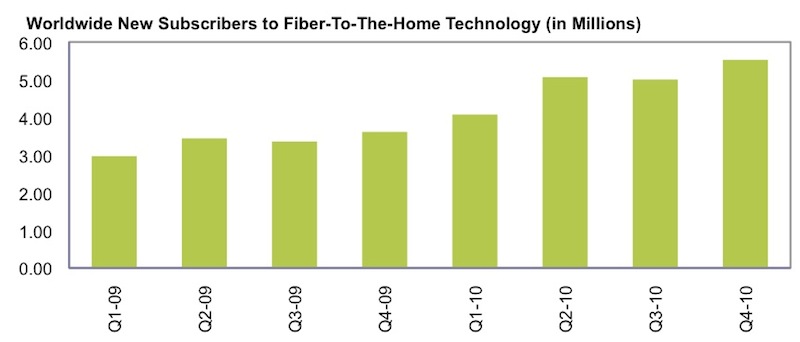 IHS iSuppli announced that, according to its latest research, Google’s fiber to the home (FTTH) experiment in Kansas City, KS is unlikely to spark a gigabit broadband revolution in North America.
IHS iSuppli announced that, according to its latest research, Google’s fiber to the home (FTTH) experiment in Kansas City, KS is unlikely to spark a gigabit broadband revolution in North America.
Unedited press release follows: www.isuppli.com
For more information visit:
Google’s Fiber to the Home Experiment Unlikely to Spark Gigabit Broadband Revolution in North America
El Segundo, Calif., April 20, 2011 — Despite Google Inc.’s recent selection of Kansas City, Kan., as the initial location for the company’s broadband networks capable of gigabit speed Internet service, it could be a decade or more before such high-speed delivery will be widely available in North America, new IHS iSuppli research indicates.
The Google announcement on March 30 marks the search giant’s first foray into fiber-to-the-home (FTTH). FTTH can deliver connections many times faster than current technologies, by means of fiber optic cable instead of the telephone companies’ traditional copper phone lines or cable operators’ hybrid fiber coax (HFC) networks. Google said the initiative will deliver speeds of up to 1 gigabit per second (Gbps) and involve as many as 500,000 subscribers.
FTTH continues to be a high-growth segment of the broadband market as deployments move forward in nearly every developed and developing country.
The move comes at a time when worldwide usage of FTTH is on the rise.
Worldwide, 5.52 million new FTTH subscribers were added in the fourth quarter of 2010, resulting in a total of 77 million subscribers, IHS iSuppli figures indicate. Except for the third quarter in both 2009 and 2010 when numbers dipped slightly, growth has accelerated throughout the last two years, as shown in the attached figure.
However, the worldwide growth in FTTH is not being reflected in North America.
“Regardless of Google’s efforts, gigabit-rate speeds may not be within reach of the average U.S. household for many years to come, conceivably up to a decade or more,” said Lee Ratliff, senior analyst for broadband and digital home at IHS. “Aside from the expected high cost, gigabit service faces other more significant obstacles to adoption, especially in North America.”
These obstacles include lack of competition among broadband providers, which is reducing pressure among them to offer faster service and lower rates. Furthermore, there are no new applications on the horizon that are driving demand for faster broadband speeds.
“These factors have contributed to moderated demand from consumers, who often don’t take advantage of higher-performance tiers of service that are available today.”
There also is a lack of fundamental demand for faster broadband among North American consumers.
“Despite the wishes of broadband activists, technology evangelists and communications equipment manufacturers, Americans remain largely ambivalent regarding broadband performance,” Ratliff said. “According to the Pew Internet 2010 poll on broadband, 51 percent of broadband subscribers subscribe to the most basic tier of service, unwilling to pay the $6.82 extra per month on average that premium subscribers pay.”
Finally, the market is being stymied by a lack of economic incentive among broadband service providers.
“Service providers know that revenue does not scale with broadband speed and that pricing is inelastic, with the sweet spot for mainstream use remaining at around $40 to $45 for Internet access regardless of speed,” Ratliff said. “And despite improvements in performance, pricing has remained relatively constant over the years. As a result, investing heavily in networks to gain a quantum leap in performance but only to earn the same revenue is often a non-starter.”
Through its effort, Google said it hopes to learn how to economically deploy and operate FTTH networks, as well as to gain insight into new types of applications that will arise when virtually unlimited bandwidth becomes available. In addition, Google will wholesale broadband access on the network, enabling multiple internet service providers (ISPs) to compete for customers, in the process providing customers with increased choice and competitive pricing.
Google’s Kansas City effort will be among the first gigabit networks in North America. Even Verizon’s FiOS FTTH network—the gold standard of broadband performance in North America—currently tops out at 150 Mbps, a fraction of Google’s promised rate. Compared to the average subscriber’s maximum rate today, the Google project will be more than 100 times faster.
Learn more about the latest in the broadband space—and Google’s FTTH effort in particular—with the IHS report entitled: Google’s FTTH Experiment Unlikely to Spark Gigabit Revolution.
About IHS iSuppli Products & Services
IHS iSuppli technology value chain research and advisory services range from electronic component research to device-specific application market forecasts, from teardown analysis to consumer electronics market trends and analysis and from display device and systems research to automotive telematics, navigation and safety systems research. More information is available at www.isuppli.com and by following on twitter.com/iSuppli.
About IHS (www.ihs.com)
IHS (NYSE: IHS) is the leading source of information and insight in pivotal areas that shape today’s business landscape: energy, economics, geopolitical risk, sustainability and supply chain management. Businesses and governments around the globe rely on the comprehensive content, expert independent analysis and flexible delivery methods of IHS to make high-impact decisions and develop strategies with speed and confidence. IHS has been in business since 1959 and became a publicly traded company on the New York Stock Exchange in 2005. Headquartered in Englewood, Colorado, USA, IHS employs more than 4,400 people in more than 30 countries around the world.
